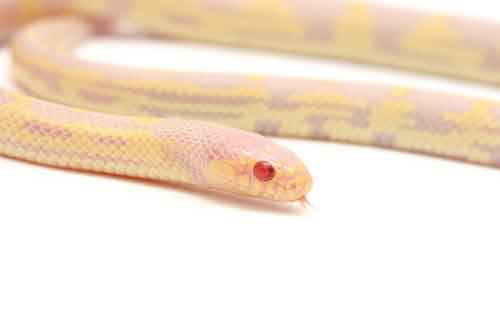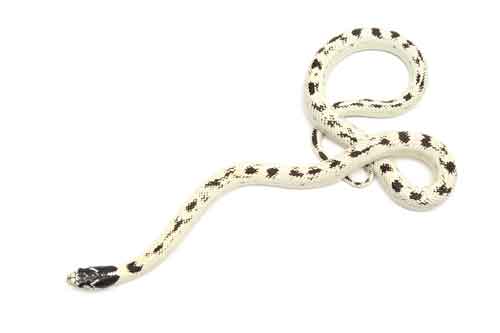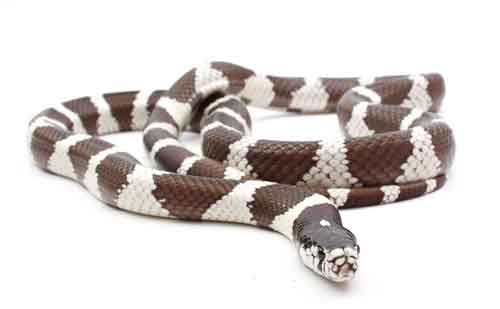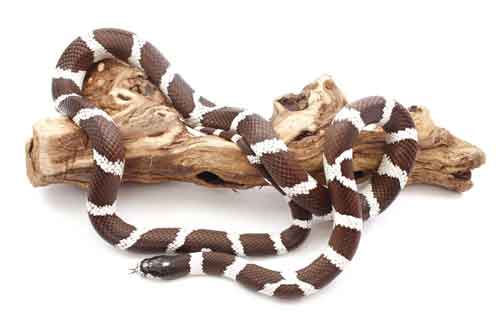Care sheet for the California kingsnake (Lampropeltis getula californiae).
Updated January 27, 2023
California Kingsnake – Lampropeltis getula californiae
California kingsnakes are one of the most commonly kept pet snakes, and for good reason. Meeting kingsnake captive requirements is easy when you prioritize reptile health and wellness, quality husbandry, and proper snake supplies. The California kingsnake is one of many subspecies of the common kingsnake. Kingsnakes range from coast to coast and north to south in all 48 contiguous United States. When a snake has this broad of a distribution, and lives in so many habitats and conditions, it is a good indicator that it will adapt easily to a life in captivity.
The California kingsnake occurs in California and touches the neighboring states of Oregon, Nevada, Arizona and Baja California. It is one of the first snakes to be bred regularly in captivity and many patterns and morphs have been developed.
California Kingsnake Availability
California kingsnakes are still common in the wild (check for state laws regulating collecting from the wild) in many areas. However, it is advantageous to get a captive-bred, parasite-free, established (feeding on rodents) kingsnake with lineage and genetic traits records. Captive-bred California kingsnakes can be purchased at pet shops, reptile shows, from breeders, and sometimes at online reptile shops.

Gina Cioli/I-5 Studio
An albino California kingsnake.
California Kingsnake Size
California kingsnakes hatch from their eggs at 8 to 12 inches. Maximum adult size for California kingsnakes is more than 6 feet in length, although average size is 3 to 4 feet. California kingsnakes are not a bulky or heavy snake, so they seem smaller than they actually are.
California Kingsnake Life Span
California kingsnakes often live for more than 20 years. Female California kingsnakes often produce fertile eggs into their low teens.
California Kingsnake Enclosure
A general rule is that if the snake crawls around the perimeter of the cage and doesn’t cover more than 2/3 of the distance, the cage is large enough – but bigger is better. A baby California kingsnake can live in a shoebox-sized cage for several months until it outgrows it. An adult California kingsnake requires a 40-gallon reptile terrarium or larger enclosure. Be sure it has a secure, escape-proof opening. If there is a weakness, the kingsnake will find it and escape!

Gina Cioli/I-5 Studio
Banana California kingsnake.
California kingsnakes will eat other snakes and should be kept alone or in breeding groups of no more than one male and several adult females. Warning: Do not raise juvenile California kingsnakes together, they could eat each other. Wait until adult size, more than 2 feet, to introduce and watch them to be sure of nonaggression. Separate to feed and keep separate for a few hours.
California Kingsnake Lighting and Temperature
California kingsnakes require no special lighting if the cage is in a room with natural light. Be sure not to place the cage in or near a window where the sun will shine on the cage, or it can become too hot and fatal for your kingsnake. (Editor’s note: The California kingsnake is a partial sun/occasional basker. It is a Zone 2 reptile under the Ferguson Zones. These zones are based on Dr. Gary Ferguson’s observations of how reptiles interact with sunlight in the wild. Choose a UVB light that offers a Zone range of 0.7 to 1.0 with a maximum UVI of 1.1 to 3.0 in the basking zone. For more on reptile lighting and UVB, please read Reptile Lighting information by Dr. Frances Baines here). California kingsnakes thermoregulate in the wild. They move about to find and maintain (when they can) a preferred temperature. Being “cold blooded” they become the temperature of their surroundings. In captivity, choices are limited to what you provide so you should have a warm end and a cool end of your cage.
There are many heaters, pads, cables and tape available from dealers to accomplish this. Some people use lights for heat, but this is not an efficient use of energy and has disadvantages. For instance, you could warm the air with the light, but the floor could still be too cool for the snake. Try to achieve 85 degrees Fahrenheit at one end and in the 70s at the cool end. Do not use “hot rocks,” the heat is too centralized and can cause burns.

Gina Cioli/I-5 Studio
A “normal” California kingsnake.
California Kingsnake Substrate
Many commercial substrates and beddings for reptiles are available. Avoid cat litter and any chemically treated substrates and oily woods. General rule, if it looks good and doesn’t give off a smell, it is OK. Feed your California kingsnake in a separate container if the substrate could be ingested while feeding. Aspen bedding and coconut coir are good substrates. Ensure the enclosure has a hide so the snake can get away when it needs to. Place one hide on the warm side of the enclosure and a second hide on the cool side.
California Kingsnake Food
In the wild, California kingsnakes will eat just about any animal or bird small enough to be overpowered and swallowed whole, including rattlesnakes. In captivity they should be fed rodents, usually mice, which are readily available. You can offer live reptile food or well-thawed frozen mice. Live adult mice can inflict wounds to your kingsnake. Fresh killed and frozen-thawed are best.
The mouse should leave a lump in the kingsnake a little larger than the snake’s normal diameter mid body. Until the snake is established with you, do not handle it until the lump has digested down to normal diameter of the snake. Feeding once a week will maintain your California kingsnake, but the snake will grow faster if you feed it twice a week or more, if it will take it. Once the kingsnake reaches adult size, avoid obesity. Reduce feeding if necessary.
California Kingsnake Water
Provide a fresh water bowl that is deep enough that when the bowl is half filled and the snake goes in to soak, the water will not overflow into the cage. You want a dry cage. If the humidity increases in the cage to where it looks or feels moist, remove the water and only offer it a couple days a week. Clean the water bowl as needed.
California Kingsnake Handling and Temperament
Even though California kingsnakes have been captive bred for generations, your snake is still wild by nature. Your new kingsnake might take a defensive stance and shake its tail and strike at you. It may defecate or urinate on you when you pick it up. This potential behavior is a natural, wild response to discourage you (a potential predator) from eating it. It is afraid!
With regular, gentle handling, your California kingsnake should settle in and make a great pet. Hand over hand, staying away from its face, with gentle friction to slow forward progress, is the preferred method for beginning handling.
Don’t handle your snake when it is about to shed. The way to detect this is that their eyes will look “milky” or bluish. After a few days they will clear and a few days after that the snake should crawl out of its entire skin (shed, slough). This care sheet is a very brief overview of a subject that would require an entire book to fully cover. Be sure to consult experts if you have further questions or have any problems. Enjoy your California kingsnake!
Bob Applegate has been known for more than 25 years as a breeder of quality and rare reptiles. His name is on two strains of snakes: the Applegate Arizona Mountain Kingsnake and the Applegate San Diego Gopher Snake.



